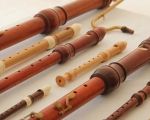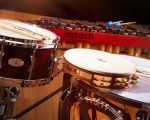Choosing the Right Drum Kit for Beginners
Starting a new musical journey is exciting, and for aspiring drummers, buying your first drum kit is an essential step. But with so many options out there, it can be overwhelming to figure out where to start. In this guide, I'll walk you through the process of choosing the perfect drum kit to begin your drumming adventure. From understanding the types of kits available to selecting the right features, I'll help you make an informed decision that suits both your needs and budget.
1. Understanding the Types of Drum Kits
When you're shopping for a drum kit, it's important to first understand the two main types: acoustic and electronic. Both have their pros and cons, and which one is right for you depends on your preferences, playing style, and where you plan to practice.
Acoustic Drum Kits: These are the traditional, full-bodied kits you often see in live performances. They come with a variety of components, including bass drums, snare drums, toms, and cymbals. Acoustic kits offer a rich, natural sound, but they can be loud and require ample space for setup. They're great if you're looking to play with a live band or in a studio where sound quality matters.
Electronic Drum Kits: These kits use pads that trigger sound samples from a digital brain. They're quieter, more compact, and allow you to adjust the volume, making them ideal for practicing in shared spaces. Electronic kits are also versatile, often offering a wide range of sounds, but they may not provide the same organic feel as an acoustic kit.
2. Setting Your Budget
Drum kits come in various price ranges, from beginner sets to professional-grade models. It's crucial to set a realistic budget before you start shopping. As a beginner, you don't need to invest in the most expensive kit right away. Instead, look for kits that offer good quality at an affordable price point, ensuring you get the best value for your money.
Expect to spend between $300 and $800 for a decent beginner kit. Entry-level acoustic kits are typically more affordable, while electronic kits might be a bit more expensive. Keep in mind that you'll also need to budget for accessories like drumsticks, a drum throne, and a practice pad.
3. Key Features to Look for
When you're browsing drum kits, there are several features to consider. For acoustic kits, make sure the drum shells are made from durable wood, as this greatly affects the tone quality. The hardware—such as the stands, pedals, and drum heads—should be sturdy and easy to adjust. For electronic kits, look for a kit that offers a variety of sounds, a responsive touch on the pads, and an easy-to-use drum module.
Other important considerations include the number of pieces in the kit (e.g., how many toms or cymbals) and whether it includes accessories like a drum throne or a cymbal stand. Many entry-level kits come with everything you need to start playing, so check what's included in the package before you buy.
4. How to Test the Drum Kit Before You Buy
If possible, try out the drum kit before you make your purchase. Many music stores have kits set up for customers to test. When trying out an acoustic kit, pay attention to how the drums sound and feel when you play them. Are they responsive? Do they produce the tone you're looking for? For electronic kits, make sure the pads are sensitive and comfortable to play, and test the sound module to see if it offers a variety of sounds that appeal to you.
Also, consider the setup process. How easy is it to assemble the kit? Some drum kits come with clear instructions, while others may be more difficult to set up. It's worth checking how user-friendly the kit is, especially if you're a beginner.
5. Buying from a Reputable Dealer
When you're ready to make a purchase, make sure you're buying from a reputable dealer. You want to ensure that you're getting a quality product, and buying from a trusted store means you'll have access to customer service and warranty options if anything goes wrong. Many well-known music stores offer expert advice, so don't hesitate to ask questions if you're uncertain about the right choice for you.
If you're shopping online, look for customer reviews and ratings. Reviews can give you a better sense of the kit's quality, how it holds up over time, and whether it's a good fit for beginners. Reputable dealers will also offer easy return policies, just in case the kit doesn't meet your expectations.
6. Maintenance and Care for Your Drum Kit
Once you purchase your drum kit, it's essential to take care of it so it lasts for years. For acoustic kits, make sure to regularly check the tension of your drum heads and replace them when needed. Clean your cymbals with a soft cloth and avoid using harsh chemicals that can damage the surface.
For electronic kits, make sure the pads are clean and free of dust. Also, check the connections regularly to ensure everything is functioning correctly. Many electronic drum kits have software updates available, so keep an eye out for new features or improvements.
Conclusion
Buying your first drum kit is an exciting step in your musical journey. With the right information, you can choose a kit that suits your style, budget, and playing environment. Whether you opt for an acoustic or electronic kit, make sure you understand the key features, test the kit before purchasing, and buy from a trusted dealer. With the right care and practice, your drum kit will serve you well as you develop your drumming skills.








